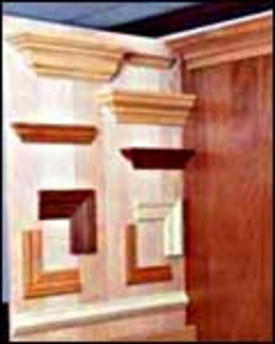Historical restoration, whether done with the utmost attention to detail or simply in the spirit of house, often requires private eye-like resourcefulness. Decades old custom details—whether they are ornamental plaster or custom woodwork—are unlikely to be found at the local home center or even the best-stocked salvage yard.
Replicating the historic details of a house is often the only solution. Custom-made replacements that match the existing or salvageable sections of millwork and moldings can keep a home’s character intact. The key hurdle is cost—unless a remodel requires 1000s of linear feet of a particular molding profile, each unique section is created from scratch using one-of-a-kind tools. Custom millwork shops can create exact replicas of even the most intricate machine-made details (handmade pieces and carvings require a different process). When Bob Forester, founder of Forester Moulding and Lumber, launched his millwork business in 1989, he was just as happy to run 100 feet of a custom profile as he was about running 10,000 feet. Current Forester president, Bill Mischel, has expanded the shop to include other services, such as the manufacture of rails, balusters, finials and other architectural details.
According to Mischel, there are a few ways to save money when contemplating custom work. Making custom moldings for every room in a 2,500-square-foot home can cost from $15,000 to $25,000 when using less-expensive poplar. The price can jump to over $50,000 if more expensive woods, such as cherry or mahogany, are used. Some woodworking shops do not charge for the cost of creating the custom tools to create new designs. They simply add a new profile to their available selection when the job is done. For small runs of unique designs you can expect to pay a setup fee to cover the cost of adjusting and testing equipment to create a new design. Once the setup is complete, the price of the wood you choose is the main consideration.
From a practical standpoint, there is little difference in hardwoods (poplar, birch, hickory, oak, maple, cherry, mahogany) and softwoods (cedar, pine) when making moldings other than individual appearances. However, specifying birch or hickory over poplar can raise a bill 25 percent. No type of wood is off-limits. If a room simply must have African mahogany or antique heart pine crown molding, the price of the wood becomes the only barrier. Once the machines are setup, it is rarely more expensive to finish one wood over another.
Also consider the size of the pieces you are replacing. Where a smaller size of lumber can be used, the savings can be worth the sacrifice. Because the base lumber is smaller, a 3/4-x-3-inch molding can cost 25 percent less than a 7/8-x-3-inch with an almost identical design. Work with your shop or a designer to find places where close substitutes can be used.
Credit: Renovate Your World




























